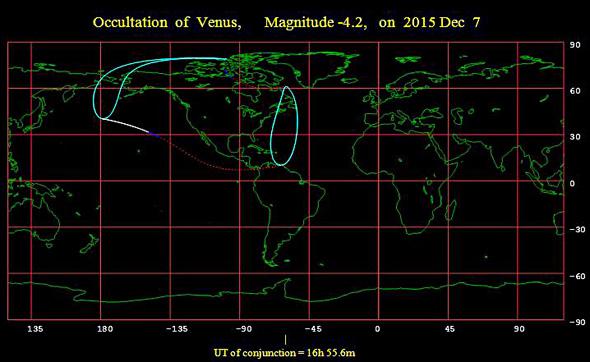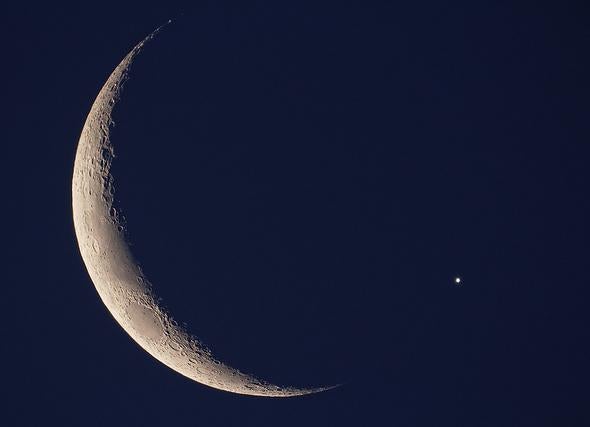Update, Dec. 7, 2015 at 16:45 UTC: Well, despite only patchy clouds earlier, we got socked in far more by the time the occultation started, and I couldn’t see the first part where Venus disappears. However, it’s due to reappear from the other side of the Moon around 11:10, so we still get another chance to see it. If it’s clear I’ll fire up Periscope again. See how to tune in below.
Monday morning, people in the U.S., Canada, and Central America will see the Moon pass directly in front of Venus, blocking it out. This event—called an occultation, but you can think of it as a sort of mini-eclipse—is a pretty cool thing to see; it doesn’t happen often and it’s pretty entertaining.
The Lunar Occultations site has a map showing who will be able to see the event. The time it happens depends on your location. Sky and Telescope has a list of times for major cities, and you can probably figure out when to go out and look based on that. But pad your estimate by several minutes! You don’t want to miss it. Universe Today has more info as well.
This event is visible to the naked eye, but binoculars will help. The Moon and Venus will be pretty far from the Sun, so you don’t have to worry too much about blinding yourself accidentally. Venus is hard to find in the sky after sunrise (though not impossible), so your best bet is to look for the thin crescent Moon, roughly 40° (an eighth of the way around the sky) from the Sun to the west.

Map via the Lunar Occultation site
The Moon will only be 13 percent illuminated, so I’m not kidding when I say it’ll be a thin crescent. Just before the occultation, Venus will be very near the lit crescent side of the Moon. If you use a telescope, you’ll see Venus is just more than half lit itself. Although Venus is physically about four times wider than the Moon, it’s 150 million kilometers away, 375 times farther than the Moon’s mere 400,000 km distance, so Venus looks far smaller.
A sky chart will help you see all this. You can go to Heavens Above, enter your latitude and longitude, then go to “Sky Chart” (you can use Google maps to get your lat and long). Or you can search on “sky maps” on Google to find other software. I use Sky Safari on my mobile devices, and I quite like it.
These events don’t usually happen very often. The Moon’s orbit around the Earth is tilted with respect to the orbit of Venus (and the other planets) around the Sun, so we don’t see the Moon pass directly in front of them every orbit. Everything has to line up just so for this to work, much like a solar eclipse.
This occultation will last quite a while, depending on your location (people at the extreme north and south parts of the Earth where this is visible will see a shorter event, because the Moon will just skim Venus). For me, near Boulder, Colorado, it’ll last more than 90 minutes.
The weather is predicted to be clear in my area, so I’ll be outside looking for this. In fact, if I can, I’ll do a live stream of the occultation using my phone hooked up to my Celestron Regal M2 80ED spotting ‘scope, which should provide a nice view. I’ll do the live streaming on Periscope. If you have the app, follow me there. If you don’t, when I start it up I’ll make an announcement on Twitter that will give you a link; you can click it and watch on the Web.
For my location, the occultation begins shortly after 9:30 a.m. Monday morning Mountain time (16:30 UTC). I’ll start it up right at 9:30 if I can. Once Venus disappears I may close up shop until just before it reappears, probably a few minutes after 11:00 Mountain time (18:00 UTC) time. Of course, this is all weather dependent!
I hope you join me. I’ll give a running commentary of the event, and answer questions people have too. I did this for the lunar eclipse in September, and it was a lot of fun! It’s fun to share the sky, especially when something out of the ordinary like this happens.
*Correction, Dec. 7, 2015: This post originally misspelled Luis Argerich’s last name.
